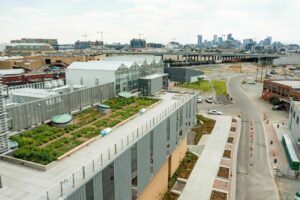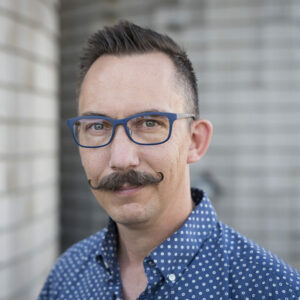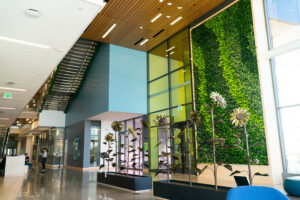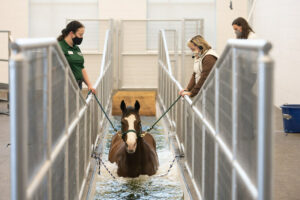CSU Spur is an unparalleled educational experience within higher education. From a research green roof and equine-assisted services, to mock pet-exam clinics for kids, the campus aims to inspire the next generation to engage in pressing issues surrounding water, food, and health.

In this blog post, we speak with Jim Bradeen, Associate Vice President for Spur Strategy. Bradeen leads operations and communications for CSU Fort Collins at the CSU Spur campus. He essentially serves as a liaison for Spur-based activities for all of our colleges, along with other divisions and units.
In my last blog on the topic of science communications, we explored seven ingredients to make science communication content more digestible to general audiences. This time, Bradeen hones in on his approach to science communication within the social media space.
Q: What gets you excited about science communication?

Science IS exciting. Understanding how the world works, how our bodies work, and imaging things as big as the universe or as small as DNA or even sub-atomic particles stimulates the mind. Science is a puzzle… and a process for solving that puzzle. I want to share that exciting and I want to make science accessible for everyone. That is what science communication is all about for me.
Q: To you, what are some of the most common barriers or struggles for scientists and researchers when it comes to science communication on social media platforms?
The perfect is the enemy of the good. As scientists, we are used to using specific and precise (and too often, unaccessible) language. We are resistant to expressing informed opinions without data to back us up. These are entirely understandable and appropriate. They also represent challenges for science communication. How do you express a complex technical idea in a tweet without “dumbing it down” (a phrase I harbor, by the way)? How do you do it without using strict nomenclature (aka jargon)? And how do you express an informed decision on a controversial topic without data and graphs and statistics to back you up? As scientists we need to develop new skill sets when it comes to science communication.
Q: What are some approaches you’ve tried to communicate complex ideas and discoveries to general audiences?
I’ve learned a lot about science communication by talking with comms professionals and through trial and error. Here are some of the things I think about:
- Social media is social. Interact. Don’t think of social media as a one way stream of information. Learn from others. Initiate conversations. Repost the experts and amplify the newest science communicators out there. Establish a community and the favor will be returned.
- A picture says a thousand words. People love pics, whether it is Instagram, Twitter, or Facebook… a picture gets attention.
- I’ve learned it is important to be ready to make mistakes and to be humble when you do… showing a willingness to learn and amplify the strength of others makes you more accessible and models a level of congeniality that social media needs.
- Participation in thematic comms campaigns (e.g., #PlantsGiving… which showcases the diversity of plant families contributing the U.S. Thanksgiving table) and even posting memes for scientific messaging can have a big impact. (But it is important to be timely in your use of memes!)
- Showcasing the impacts of others, especially students and early career professionals, and showcasing the wonderful diversity of our scientific communities have been well received–the “human behind the science” angle resonates with many and makes science accessible.
- Focusing on science impacts (the “why”) rather than processes (the “how”) is also an important way to lead… keep it relatable. Once you’ve opened the door, try for more information about the process.
Q: What gaps have you experienced with bridging higher education to local communities within which they serve?

There are issues out there that are polarizing. Vaccines, GMOs, evolution… we all have our list of science topics that someone always asks about. In each of these cases one’s opinion for or against has taken on political or cultural meaning and too often is interpreted as a proxy for whether you are a “good” or “bad” person. These topics represent significant gaps between higher education and the broader community. And having meaningful conversations about these topics is hard.
This isn’t necessarily a science communication problem–the challenges are bigger than that. But as scientists, we do find ourselves in positions where earnest people ask earnest questions about topics we know something about that warrant response. Relating on neutral ground is key. As a plant scientist, I get asked at every cocktail party I go to about GMO foods. I always start the conversation with “I’m glad you care about your food, where it comes from, and what it does to the environment. I do, too.” Establishing common ground is important to having a respectful conversation. This can open the door for more detailed discussions (note that I use the word “discussions” instead of “lectures” or “monologues”!) But beware that on some of these issues, opinions can be calcified and some might be more interested in “winning” the conversation rather than engaging in dialogue. But when someone asks an honest question, that is an opportunity for an honest conversation Taking these opportunities to bridge these gaps in knowledge or trust is an important part of science communication.
Q: As CSU enters a new chapter of engaging with families and communities unlike before with CSU Spur, what are some examples of how CSU Spur could address those gaps?

To me, CSU Spur is both a space and a community positioned to grapple with and ultimately address some of the grand challenges we all share: the need for good health, sustainable food production, and safe and ample water. CSU Spur brings people together and communication underpins everything we do; engaging in dialogue with underserved communities, potential students, lifelong learners, and rural and urban Coloradans is a hallmark of CSU Spur. Spur also provides a platform for lifelong, experiential learning delivered in familiar and new ways. With interactive exhibits throughout our buildings, residential non-profit partners, and 45 projects led by Fort Collins-based project teams already on the ground, CSU Spur is changing how education is delivered–and who gets to participate. It is the perfect venue for science communication in its many forms. And we are just getting started!